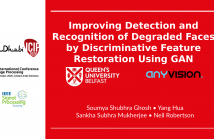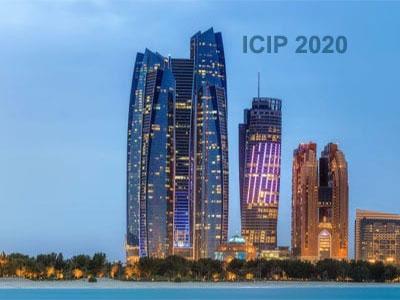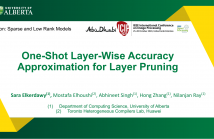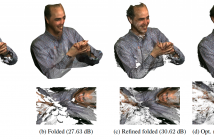
- Read more about Improving Detection and Recognition of Degraded Faces by Discriminative Feature Restoration Using GAN
- Log in to post comments
Face detection and recognition in the wild is currently one of the most interesting and challenging problems. Many algorithms with high performance have already been proposed and applied in real-world applications. However, the problem of detecting and recognising degraded faces from low-quality images and videos mostly remains unsolved. In this paper, we present an algorithm capable of recovering facial features from low-quality videos and images. The resulting output image boosts the performance of existing face detection and recognition algorithms.
- Categories:
 31 Views
31 Views
- Read more about The Good, the Bad, and the Ugly: Neural Networks Straight from JPEG
- Log in to post comments
Over the past decade, convolutional neural networks (CNNs) have achieved state-of-the-art performance in many computer vision tasks. They can learn robust representations of image data by processing RGB pixels. Since image data are often stored in a compressed format, from which JPEG is the most widespread, a preliminary decoding process is demanded. Recently, the design of CNNs for processing JPEG compressed data has gained attention from the research community.
- Categories:
 56 Views
56 Views
- Read more about Development of New Fractal and Non-fractal Deep Residual Networks for Deblocking of JPEG Decompressed Images
- Log in to post comments
slides.pdf
- Categories:
 17 Views
17 Views
- Read more about Pairwise Adjacency Matrix on Spatial Temporal Graph Convolution Network for Skeleton-based Two-Person Interaction Recognition
- Log in to post comments
Spatial-temporal graph convolutional networks (ST-GCN) have achieved outstanding performances on human action recognition, however, it might be less superior on a two-person interaction recognition (TPIR) task due to the relationship of each skeleton is not considered. In this study, we present an improvement of the ST-GCN model that focused on TPIR by employing the pairwise adjacency matrix to capture the relationship of person-person skeletons (ST-GCN-PAM). To validate the effectiveness of the proposed ST-GCN-PAM model on TPIR, experiments were conducted on NTU RGB+D 120.
- Categories:
 101 Views
101 Views
- Read more about GLAUCOMA DETECTION FROM RAW CIRCUMPAPILLARY OCT IMAGES USING FULLY CONVOLUTIONAL NEURAL NETWORKS
- Log in to post comments
- Categories:
 26 Views
26 Views
- Read more about One-Shot Layer-Wise Accuracy Approximation for Layer Pruning
- Log in to post comments
Recent advances in neural networks pruning have made it possible to remove a large number of filters without any perceptible drop in accuracy. However, the gain in speed depends on the number of filters per layer. In this paper, we propose a one-shot layer-wise proxy classifier to estimate layer importance that in turn allows us to prune a whole layer. In contrast to existing filter pruning methods which attempt to reduce the layer width of a dense model, our method reduces its depth and can thus guarantee inference speed up.
- Categories:
 59 Views
59 Views
- Read more about MULTI-SCALE EXPLAINABLE FEATURE LEARNING FOR PATHOLOGICAL IMAGE ANALYSIS USING CONVOLUTIONAL NEURAL NETWORKS
- 1 comment
- Log in to post comments
- Categories:
 21 Views
21 Views
Existing techniques to compress point cloud attributes leverage either geometric or video-based compression tools. We explore a radically different approach inspired by recent advances in point cloud representation learning. Point clouds can be interpreted as 2D manifolds in 3D space. Specifically, we fold a 2D grid onto a point cloud and we map attributes from the point cloud onto the folded 2D grid using a novel optimized mapping method. This mapping results in an image, which opens a way to apply existing image processing techniques on point cloud attributes.
- Categories:
 21 Views
21 Views
- Read more about JOINT IMAGE SUPER-RESOLUTION VIA RECURRENT CONVOLUTIONAL NEURAL NETWORKS WITH COUPLED SPARSE PRIORS
- Log in to post comments
- Categories:
 7 Views
7 Views
- Read more about Kernelized Dense Layers For Facial Expression Recognition
- 1 comment
- Log in to post comments
Fully connected layer is an essential component of Convolutional Neural Networks (CNNs), which demonstrates its efficiency in computer vision tasks. The CNN process usually starts with convolution and pooling layers that first break down the input images into features, and then analyze them independently. The result of this process feeds into a fully connected neural network structure which drives the final classification decision. In this paper, we propose a Kernelized Dense Layer (KDL) which captures higher order feature interactions instead of conventional linear relations.
- Categories:
 11 Views
11 Views